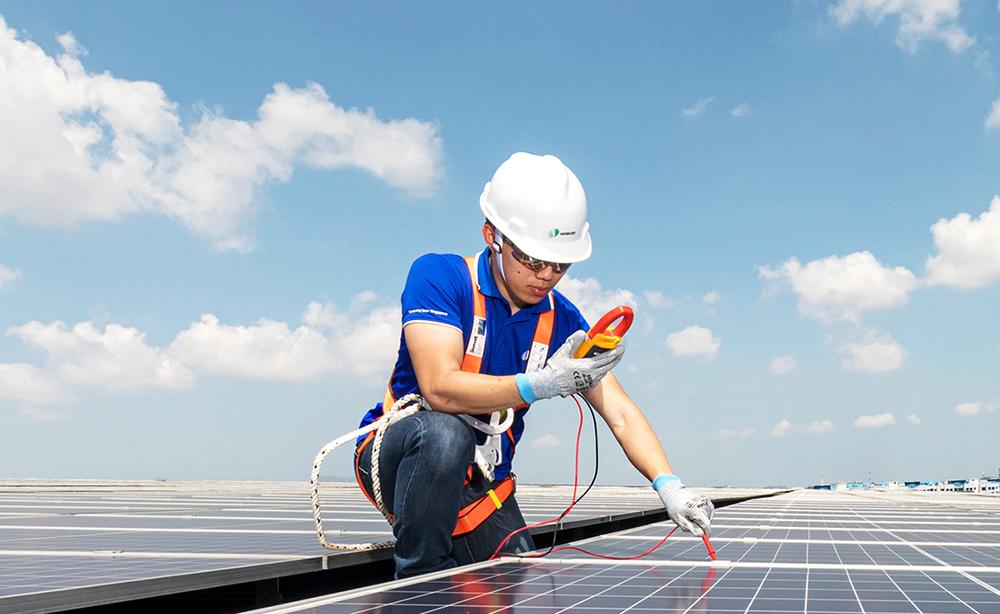
Sembcorp is supplying solar systems to both ST Engineering and SIA Engineering in Singapore.
A system of solar panels completed about a year ago saved the aerospace unit of ST Engineering S$4 million ($2.9 million) in the last 12 months. The system had originally been expected to saved S$12 million ($8.8 million) over 25 years, or an average of S$0.5 million a year ($370,475), so the actual gain was about eight times the expected saving.
The MRO’s solar system has 10.6 megawatts of peak capacity, the power generated with the sun directly above in a cloudless sky. The solar panels are now installed at three facilities, including Paya Lebar in eastern Singapore, which was fully commissioned in March 2022. In all, there are 25,000 solar panels that avoid about 5,500 metric tons of annual carbon dioxide (CO2) emissions.
ST Engineering buys electricity at fixed prices from Sembcorp, a solar company that pays for the installation and operation of the solar system. The Sembcorp solar system generated 10,000 megawatt hours of energy, sufficient to cut the MRO’s power needs by 30% over the last 12 months. Both these figures are around what ST Engineering originally expected.
The much greater gain from solar stems from the fact that electricity prices have risen much more than expected. “Our initial estimates were based on a fixed brown [fossil-fuel-powered] grid rate,” explains a spokesperson for ST Engineering. “Our savings in the last 12 months increased due to higher fuel costs in 2022.”
Solar savings should also be substantial for Singapore International Airlines and its MRO unit, SIA Engineering, which has installed a slightly smaller system. The system has 8.2 megawatts of peak capacity provided by 20,000 panels, and it is expected to cover 18% of airline and MRO power needs. SIA originally expected a slightly higher power reduction of 10,200 megawatt hours a year. Like ST Engineering, SIA buys the power from Sembcorp, which builds and operates the system.
ST Engineering is planning other green initiatives, such as converting to electric operational support vehicles. It plans to eventually convert its diesel-powered ground support equipment, such as boom lifts, forklifts, ground power units and air-conditioning units, to hybrid-electric power. It has also made small operational changes, such as setting temperatures to no more than 24C (75.2F) in high-traffic office areas, while normal office environments are set at 25C (77F).
Would the solar approach work for other MROs? The economics of solar power are very site-specific, depending on the amount and angle of sunshine a location gets, distribution costs and other factors. One very important variable is the amount of solar energy, or insolation, available during a typical year.
Located just 17 mi. from the equator, Singapore would be extremely favored by long and relatively direct solar radiation. But the aviation hub is in the tropics and subject to monsoons, with rain on 167 days in an average year, and the sun shining through only 4-5 hr. per day during the wettest months and 8-9 hr. during drier periods, yielding about 1,700 kilowatt hours per square meter in annual insolation. Therefore, Singapore is only moderately favored by sunshine, albeit much better off than northern Europe or Canada, with about 1,100 kWh/m2. It also has less insolation than hot and dry areas in the Middle East, northern Africa, much of Australia, Mexico and the southwest U.S., which can get above 2,200 kWh/m2.
Where solar resources are ample, MROs may not have to act alone. For example, the United Arab Emirates is moving aggressively to install solar systems in the nearby desert. In the hot and dry U.S. Southwest, solar already generates more than a quarter of electricity in California, 23% in Nevada and 10% in Arizona. By tapping into power grids, MROs in these areas could get a substantial part of power from solar.
Still, installing solar panels locally avoids relying on distant power, as well as complicated and delayed processes for adding solar to grids, especially where suitable land is scarce. Thus, HAECO began installing 6,000 panels and 3 peak megawatts of solar in Honk Kong (about 1,200 kWh/ m2) in 2021. It is considering installing solar at its North Carolina (1,700 kWh/m2) and Utah (1,900 kWh/ m2) facilities.





